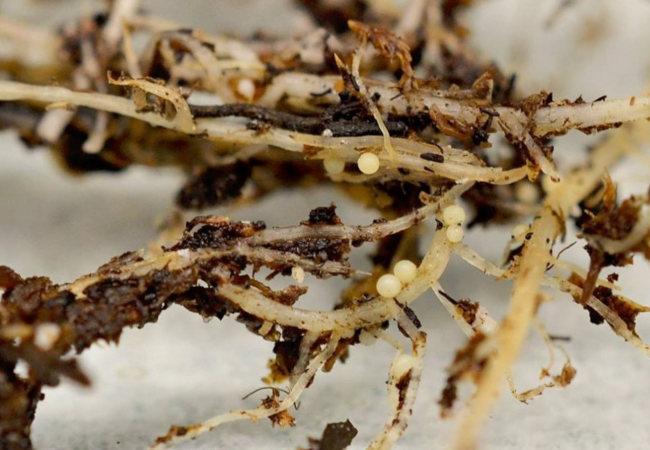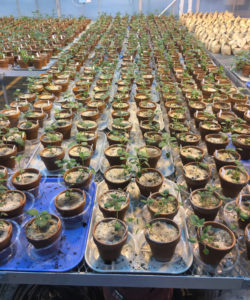
Arming against the pale cyst nematode threat
Potato production in the U.S. and the viability of international markets for U.S. potatoes are threatened by the presence and potential geographic spread of the invasive cyst nematodes G. rostochiensis (golden nematode) and G. pallida (pale cyst nematode). Known as potato cyst nematodes (PCN), these nematodes are of worldwide regulatory concern and are two of the most economically important pests of potato, causing up to 80 percent yield loss in infested fields.
The presence of G. rostochiensis in New York, the unexpected appearance of G. pallida in Idaho in 2006, and the emergence of a new pathotype of G. rostochiensis (Ro2) in New York, all highlight the threat that this group of nematodes poses to the multi-billion-dollar U.S. potato industry. Potato is also a host for the recently discovered cyst nematode, Globodera ellingtonae. However, G. ellingtonae is not regulated because potato appears to be tolerant to G. ellingtonae; pathogenicity has yet to be established. The annual economic impact of G. pallida for the state of Idaho alone has been estimated to be $30 million (McIntosh, et al., personal communication).
Stages of development
Nematode juveniles and adults resemble worms, earning them the common name “roundworms.” They have six life stages: egg, four juvenile stages and adult. Potato cyst nematodes have both male and female adult forms and reproduce sexually. Potato cyst nematodes are obligate parasites of several solanaceous plant hosts. Globodera are among the most challenging plant pests to control because the body of a dead female has hundreds of eggs encysted, or enclosed, in the cyst.
Cysts with viable eggs can persist in soil for decades, surviving chemical and biological stresses until eggs hatch from exposures to root exudates from plant hosts such as potato. For that reason, movement of infested soil on harvested plant parts or farm equipment is typically how these nematodes move from field to field or across international borders.
Eggs in cysts can remain viable for many years in the absence of susceptible hosts. When eggs hatch, the second-stage juveniles emerge and swim short distances to roots, then penetrate, feed and complete their life cycle. Extensive nematode feeding saps plant nutrients and can result in greatly reduced crop yields. Uncontrolled nematodes dramatically increase populations in potato fields.
Planting resistant varieties has been one of the most effective control measures for many plant diseases and pests. However, among the more widely grown russet varieties in the U.S., none have resistance to potato cyst nematodes and only two non-russet varieties have resistance to G. rostochiensis pathotype Ro2. There are no commercially acceptable potato varieties in the U.S. with G. pallida resistance that could be planted into deregulated fields.
Developing resistant varieties
One major goal of the Globodera Alliance coordinated agricultural project (GLOBAL) funded by USDA-NIFA, is to develop resistant varieties. Growers need  potato cultivars with complete resistance to the species and pathotypes of Globodera that are present, as well as to those which could be introduced. Resistant sources are limited, but the Globodera spp. threat to the potato industry would be greatly reduced if varieties existed with resistance to all three cyst nematodes, G. pallida, G. rostochiensis and G. ellingtonae.
potato cultivars with complete resistance to the species and pathotypes of Globodera that are present, as well as to those which could be introduced. Resistant sources are limited, but the Globodera spp. threat to the potato industry would be greatly reduced if varieties existed with resistance to all three cyst nematodes, G. pallida, G. rostochiensis and G. ellingtonae.
Over the years, efforts to incorporate a resistance gene (H1) into potatoes has produced many G. rostochiensis resistant varieties. This gene is very effective for nematode races (pathotypes) Ro1 and Ro4. A resistance scale ranks a potato variety from 1 (no resistance) to 9 (high resistance). Using this scale, many resistant varieties with the H1 gene come in at a 9. This is major gene resistance and it is inherited in a simple, dominant fashion. Fortunately, our GLOBAL group has determined that any potato variety that has the H1 gene also has high resistance to G. ellingtonae.
Success in controlling G. rostochiensis races Ro1 and Ro4 has been achieved using varieties carrying the H1 gene. However, use of these varieties has, over time, revealed that some G. rostochiensis populations contain another race, Ro2, that is not controlled by this gene. Ro2 has become an issue in New York and some European countries where H1 resistance is frequently used.
Resistance to G. pallida has been found in a few sources, including Solanum vernei, a wild potato species, and S. tuberosum subsp. andigena, a cultivated Andean sub-species. Resistance from these sources has been transferred into a few commercial varieties. However, the resistance is not based on major genes, but on contributions from multiple genes, each of relatively small effect. These genes are also known as minor genes or Quantitative Trait Loci (QTLs). Resistance against G. pallida is not as effective as resistance the H1 gene confers against G. rostochiensis. Pyramiding or stacking resistant genes from more than one source can increase the level of resistance in an additive or synergistic fashion.
Resistant potato populations have been developed that combine different sources of resistance (those QTLs mentioned earlier). Varieties from these crosses, with pyramided genes for G. pallida and G. rostochiensis resistance, can be used as a sustainable method to reduce and help eliminate nematodes in infested soil. Some varieties developed may be resistant to G. pallida and not G. rostochiensis or vice versa.
Limiting PCN spread
Regulatory measures in New York have limited the spread of G. rostochiensis; and the nematode remains contained. Use of resistant varieties, introduced in the 1980s, greatly benefited growers in New York so they could return to potato production with regulatory oversight. Extensive sampling of Idaho fields since 2006 has shown that the G. pallida infestation is limited. The quarantine measures taken have allowed the U.S. and Idaho to regain important foreign markets that initially closed because of the nematode. Eradication efforts for G. pallida in Idaho are ongoing with the goal to return fields to normal production. These efforts include fumigation, extensive sampling and a core set of parameters to be met before a field is released for potato production.
The goal to develop resistant varieties will ultimately help in eradication of PCN. More time and resources are needed to develop varieties with high resistance to G. pallida and G. rostochiensis (Ro1 and Ro2) as well as G. ellingtonae. The GLOBAL group has made progress in achieving broad resistance to potato cyst nematodes with our efforts being a component of an integrated approach for the management of these destructive pests of potato.
— Potato Association of America







